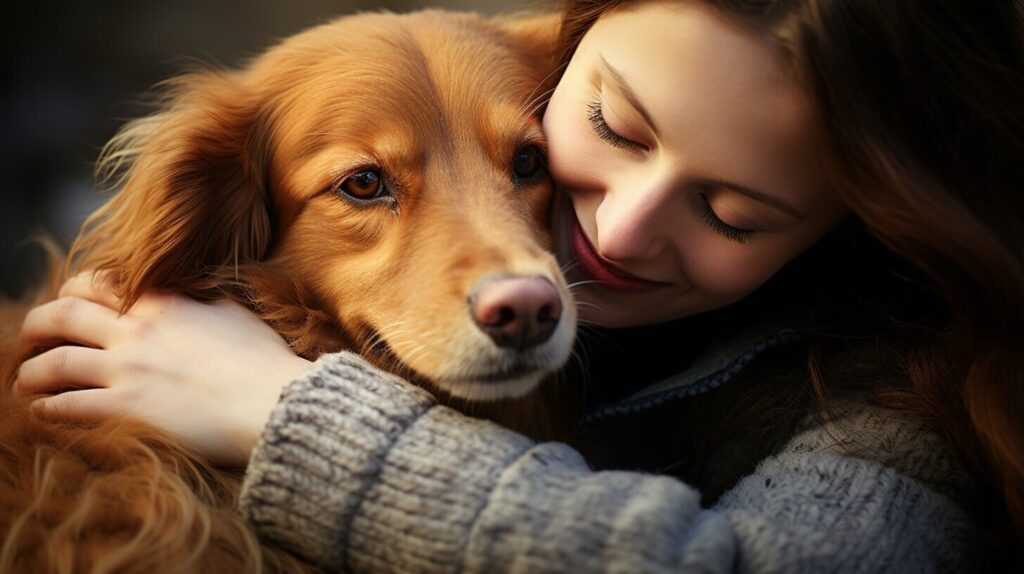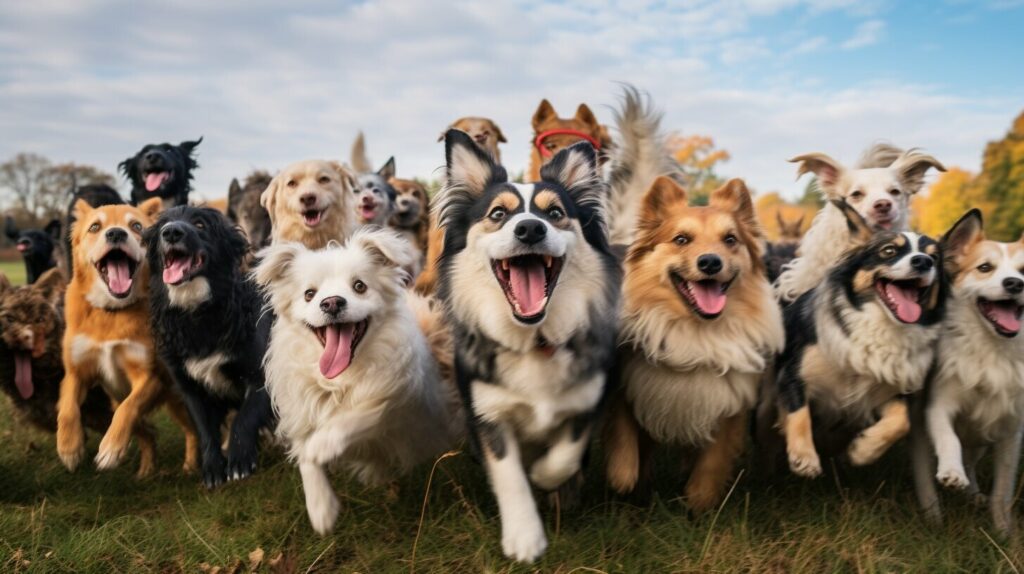Have you ever wondered why your furry friend loves to give you slobbery kisses? Dogs have a natural instinct to lick, and it’s their way of communicating with you. Licking can signify a range of behaviors, from showing affection to conveying their needs. In this section, we’ll explore why dogs engage in licking and the reasons behind their behavior.
Key Takeaways:
- Dogs lick to communicate with their owners.
- Licking can signify a range of behaviors, including affection, submission, and seeking attention.
- Understanding your dog’s licking habits can help decode their behavior effectively.
Dog Licking as a Sign of Affection
Have you ever wondered why your furry friend loves to lick you? Dog licking behavior is a way for your pet to show affection and communicate their love towards you. Dogs have been known to display their feelings through different gestures, and licking is among the most common.
When dogs lick their owners, it releases endorphins that make them feel happy and content. In addition, it’s a way for dogs to bond with their human companions, strengthening the emotional connection between them. Puppies, in particular, use licking as a way to show submission and affection towards their mothers.
Some dogs may even lick other animals or strangers they meet as a way to show friendliness and establish a positive relationship. Therefore, dog licking is not only a sign of affection towards their owners but also a way to communicate with the world around them.
Dog’s Way of Showing Love
For dogs, licking is one of the primary ways they communicate their emotions and show affection towards their owners. It’s their way of saying, “I love you.” So, the next time your dog licks your face, remember that they are not only showing you their love but also strengthening their bond with you.
Canine Communication Through Licking
Did you know that your dog’s licking behavior is also a way of communicating with you? Understanding your dog’s licking habits can help you interpret their intentions and emotions more accurately.
Dogs use licking to convey different messages, like seeking attention, expressing submission, or conveying their needs. A quick, small lick generally means, “Hello, I’m here.” Licking your face or hands may indicate that they want to play or get your attention. When they lick your leg or feet, it might be their way of asking for food or a walk.
Excessive licking in one particular area, such as your hands, might indicate anxiety or stress. Paying attention to the context of your dog’s behavior will help you understand what they want to communicate.
Furthermore, dogs may use licking as a form of reconciliation. After a fight or disagreement, they may approach the other dog or the affected person and lick them as a way of apologizing or showing their desire to make amends. Similarly, they may also lick wounds- both their own and other dogs’- as a form of comforting or providing oral care.
Overall, understanding your dog’s licking behavior is crucial for interpreting their emotions and needs. Paying attention to the context of their licking, as well as any accompanying vocal or body language, can help you understand what they want to communicate better.
The Significance of Dog’s Licking Behavior
Have you ever wondered why your furry friend licks you so much? Dog licking behavior holds significant meaning and can vary based on the specific context. By decoding their behavior, you can gain a deeper understanding of your dog’s needs and emotions.
Dogs lick their owners for various reasons, including grooming, marking territory, and seeking reassurance. Grooming is a natural instinct for dogs, and licking their owners’ skin and fur is a way of replicating this behavior. Marking territory is also common, and dogs use their tongues to leave their scent on objects and people they consider their own.
Additionally, licking is a way for dogs to seek reassurance and bond with their owners. Dogs often lick their owners as a sign of affection and love. It’s a genuine display of their emotions and plays an essential role in strengthening the bond between dogs and their human companions.
Understanding why dogs lick their owners is crucial in interpreting their behavior. By recognizing their needs, you can respond appropriately and nurture a healthy relationship with your furry friend.
It’s important to note that dog licking behavior can also have health-related implications. Excessive licking can be a sign of underlying health issues, such as allergies or skin problems. Monitoring your dog’s licking habits and consulting with your veterinarian can help ensure your pet’s well-being.
In conclusion, the significance of dog licking behavior goes beyond simple grooming and affection. By decoding their behavior and recognizing their needs, you can strengthen your bond with your furry friend and ensure their overall well-being.
Dog Licking and Health: Understanding Potential Implications
Dog licking behavior is a natural and endearing canine trait, and most pet owners enjoy their pet’s affectionate licks. However, excessive licking can be a sign of underlying health concerns.
Some dogs may develop skin allergies that cause itching and discomfort. These allergies could result in excessive licking, leading to rashes or hair loss. It is important to monitor your dog’s licking habits and consult with a veterinarian if you suspect any health concerns.
Moreover, dogs’ constant licking can expose you to harmful bacteria, leading to potential infections. Therefore, practicing regular hand washing and discouraging face licking can help prevent such infections.
Additionally, licking objects or surfaces outside can expose dogs to toxic substances that could affect their health. For example, antifreeze and pesticides are toxic to dogs and can easily be ingested while licking surfaces. Keeping a watchful eye on your dog and restricting access to hazardous outdoor areas can help prevent such occurrences.
Overall, proper and regular monitoring of your dog’s licking behavior is essential to ensure their well-being and prevent any related health implications.
Training and Managing Dog Licking
As a responsible pet owner, it’s essential to train your dog to manage and control their licking behavior. Here are some tips that can help:
- Establish Boundaries: Set clear boundaries on where and when your dog can lick you. This can include discouraging them from licking your face, especially if you have sensitive skin or allergies.
- Redirect Their Attention: If your dog starts licking excessively, redirect their attention to a toy, treat, or activity to distract them from licking.
- Positive Reinforcement: Use positive reinforcement techniques, such as rewards and praise, to reinforce good behavior and discourage excessive licking.
- Seek Professional Help: If your dog’s licking behavior is causing issues or distress, consider seeking the guidance of a professional dog trainer or behaviorist.
Remember, while licking is a natural and affectionate behavior, it’s essential to manage and control it to prevent any issues that may arise from excessive licking.
Curbing Overly Licking Habits
If your dog develops a habit of excessive licking, it’s essential to intervene before it becomes a problem. Understanding why dogs lick humans can help you identify potential causes and address them effectively.
To curb overly licking habits, start by identifying the triggers. Is it boredom, anxiety, or stress? Once you’ve identified the underlying cause, you can take steps to redirect their behavior.
One effective technique is to distract your dog with a toy or treat whenever they start licking excessively. Positive reinforcement can also go a long way in promoting good behavior. When your dog refrains from licking, reward them with praise or a treat.
If your dog’s licking habit persists, consult with a veterinarian or a professional dog behaviorist. They can help identify any underlying health or behavioral issues and develop a customized plan to address the problem.
The Role of Breed and Individual Personality
Dog licking behavior can vary based on the specific breed and individual personality traits. Some breeds, such as retrievers and spaniels, are known for their affectionate and social nature, which may result in more frequent licking behavior. On the other hand, breeds such as terriers and hounds may exhibit less licking behavior due to their independent personalities.
Individual differences in personality can also affect a dog’s inclination to lick. Dogs with an anxious or nervous temperament may engage in excessive licking behavior as a coping mechanism, while more confident dogs may lick as a means of showing affection and bonding with their human companions.
It’s essential to understand the characteristics of your dog’s breed and individual personality to better interpret their licking behavior and establish appropriate boundaries.
Encouraging Healthy Interactions with Dogs
Dogs have a natural inclination to lick humans as a sign of affection and communication. As a dog owner, it’s essential to encourage healthy interactions with your furry friend, while also setting boundaries to prevent excessive licking. Here are some tips to help you manage your dog’s licking behavior:
- Practice proper hygiene: Dogs’ mouths harbor bacteria, so it’s essential to wash your hands after being licked. Additionally, discourage your dog from licking your face or any open wounds to prevent the spread of infection.
- Set boundaries: Establish clear boundaries with your dog, such as avoiding licking certain body parts or furniture. Be consistent in enforcing these limits to avoid confusion on your dog’s part.
- Provide positive reinforcement: Reward your dog with treats and praise when they exhibit desired behaviors and avoid excessive licking. This will encourage your dog to repeat these actions in the future.
- Redirect their behavior: If your dog exhibits excessive licking, it may be due to boredom or stress. Provide them with interactive toys and activities to keep them mentally and physically stimulated, or consider consulting with a professional dog trainer.
- Monitor their health: Excessive licking can be a sign of underlying health issues, such as allergies or anxiety. Regular veterinary visits can help identify and address any potential health concerns.
By following these tips, you can foster a healthy and affectionate relationship with your furry friend while also curbing any unwanted or excessive licking behavior.
Conclusion
Why do dogs lick you? This age-old question has puzzled pet owners for generations. Through our exploration of dog licking behavior, we have gained a deeper understanding of the significance of this behavior and how it plays a vital role in strengthening our bond with our furry friends.
Dog licking behavior is a form of communication and can convey various messages, including affection, grooming, and seeking reassurance. Understanding the reasons behind your dog’s licking habits can help you better interpret their intentions and strengthen your relationship with them.
However, it’s also essential to monitor your dog’s licking behavior for any underlying health issues and establish boundaries to prevent unwanted or excessive licking. By training and managing your dog’s licking behavior, you can ensure their well-being and foster healthy interactions.
Overall, embracing dog licking behavior can enhance the relationship between you and your furry companion. So the next time your dog licks you, remember the various reasons behind their behavior and cherish the bond you share.
FAQ
Q: Why do dogs lick humans?
A: Dogs lick humans for various reasons, including showing affection, communicating their needs, and grooming.
Q: Is dog licking a sign of love?
A: Yes, dog licking is often a display of affection and love towards their human companions.
Q: How can I interpret my dog’s licking habits?
A: By observing the context and accompanying behavior, you can better understand if your dog is seeking attention, expressing submission, or conveying a specific need.
Q: What does excessive licking indicate?
A: Excessive licking can be a sign of underlying health issues, stress, anxiety, or boredom. It’s important to monitor your dog’s licking habits for any changes or excessive behavior.
Q: How can I manage my dog’s licking behavior?
A: Establishing boundaries, providing appropriate training, and redirecting their behavior can help manage your dog’s licking habit. Consistency and positive reinforcement are key.
Q: What should I do if my dog has developed a habit of excessive licking?
A: If your dog is over-licking, it is advisable to consult with a veterinarian to rule out any underlying medical conditions. They can provide guidance on addressing and managing the behavior.
Q: Do different dog breeds have different licking behaviors?
A: Yes, different dog breeds may exhibit varying levels of licking behavior. Some breeds are known to be more prone to licking, while others may engage in it less frequently.
Q: How can I encourage healthy interactions with dogs?
A: Encouraging healthy interactions includes practicing proper hygiene, setting boundaries for licking, and using positive reinforcement to reinforce desired behavior.



